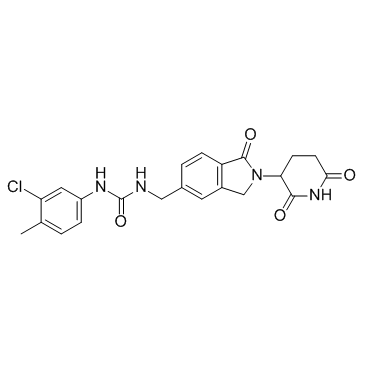| Description |
CC-885 is a cereblon (CRBN) modulator with potent anti-tumour activity.
|
| Related Catalog |
|
| Target |
CRBN[1].
|
| In Vitro |
Acute myeloblatlic leukemia (AML) cell lines, human liver epithelial cell line (THLE-2) and human peripheral blood mononuclear cells (PBMC) are treated with varying concentrations of CC-885, with IC50s of 10×-6-1 μM. The effect of CC-885 on cell proliferation in AML cell lines, THLE-2 and human PBMC is more powerful than Lenalidomide and Pomalidomide with IC50s>10 μM. To address whether the cereblon-dependent degradation of GSPT1 is responsible for the cytotoxic effects of CC-885, a GSPT1 mutant that retains its normal function, but loses CC-885-dependent cereblon binding, is used to distinguish the role of GSPT1 from that of other substrates. CC-885 is tested in 293T HEK cells stably expressing the CC-885-sensitive or -resistant GSPT1 variants. Overexpression of a resistant variant GSPT1Δ(1–138)/(G575N) completely abrogate the CC-885-induced anti-proliferation, whereas overexpression of a CC-885-sensitive variant GSPT1Δ(1-138) only confer partial protection. Similar results are obtained in AML cell lines[1].
|
| Cell Assay |
Human cancer cell lines cultured in the growth medium are seeded into black 384-well plates containing DMSO or test compounds such as CC-885 (10×-6-1 μM). The seeding density for each cell line is optimized to allow the cell growth in the linear range during a 3-day culture period. To test the compound effect on cell proliferation in acute myeloid leukaemia (AML) cell lines, 5,000 to 10,000 cells per well in 200 μl complete culture media are seeded into black 96-well plates containing DMSO or test compounds such as CC-885. After 48 or 72 h, cell proliferation is assessed using the CellTiter-Glo (CTG) Luminescent Cell Viability Assay[1].
|
| References |
[1]. Mary E. Matyskiela, et al. A novel cereblon modulator recruits GSPT1 to the CRL4CRBN ubiquitin ligase. Nature. 2016 Jul 14;535(7611):252-7.
|
